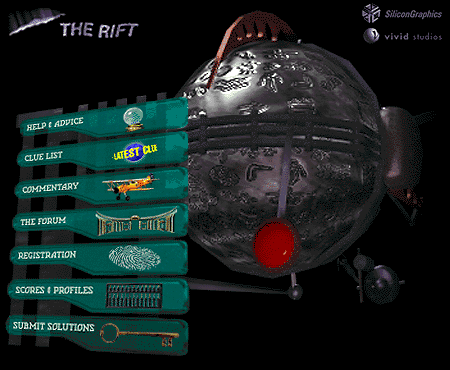Silicon Graphics wanted to promote the Indigo2 IMPACT, their latest and most advanced desktop workstation. They also wanted to introduce people to their new VRML browser, WebForce. The Rift was a net-based scavenger hunt designed to highlight the features of the new machine and new technologies, as well as showcase the many things these are used for in various industries and many of SGI’s partners and customers.
1995
Participants:
AnnD Canavan: Project Management
Lynnly Labovitz: Project Management
Nathan Shedroff: Creative Direction, Visual Design
Maurice Tani: Design and Production
Drue Miller: Clue Master, Writer
Todd Kreiger: Writer
Karin Macdonald: Clue Management
Raoul Rickenberg: Interaction and Information Design
Hussein Kanji: HTML
Jake Donham: HTML and Programming
Nat Johnson: HTML and Programming
Zachary Smith: Programming and Database Engineering
Ty Shippman: Database Design
Paul Guth: System Administration
Brian Ng: System Administration
Contrsuct Corp.: Design of the Rift Surfer and virtual worlds, as well all VRML coding
The Rift was a three week-long series of wordplay, puzzles, and VRML playgrounds, combining sci-fi fantasy and cyberculture sensibilities with technological and historical innovation. The plot revolved around the Rift Surfer, an interdimensional entity running amok and wreaking havoc on history. Each clue was written or produced to highlight a problem in space and time when two different histories would collide and need to be fixed.
Players from around the world would log onto the site to find out what mayhem the Rift Surfer had caused and set about correcting it. Clues were posted twice daily, and solutions to the clues lay scattered about the Internet, on Silicon Graphics’ customer sites and elsewhere. Two different VRML worlds were available during the game for players to test drive the WebForce browser and acquaint themselves with an exciting, emerging technology.
One of the most noteworthy aspects of The Rift was the community that developed around it. Players interacted heavily with each other, in the game discussion area, over email, and via Internet Relay Chat (IRC). Some players even created their own Rift-related websites (the “I Hate Clue #10 Page” and “Unofficial Rift Help Page” were especially memorable). Players formed teams, forged alliances, and helped each other out in ways that extended the gameplay far beyond the edge of the monitor.
The game included player profiles, a twice daily report of The Rift’s activity, excerpts from the IRC channels, hints, and status updates.
The threaded discussion area allowed players to meet each other, team up, cheat, rant, rave, and generally communicate with others playing the game
vivid was responsible for designing the game, creating all content (text, graphics, audio/video, and clues), directing the development of the VRML worlds, and handling all engineering issues (including HTML, scripting, and database design and construction), as well as providing daily game administration. vivid also helped Silicon Graphics promote The Rift to the media and on the Internet.

Recent Comments